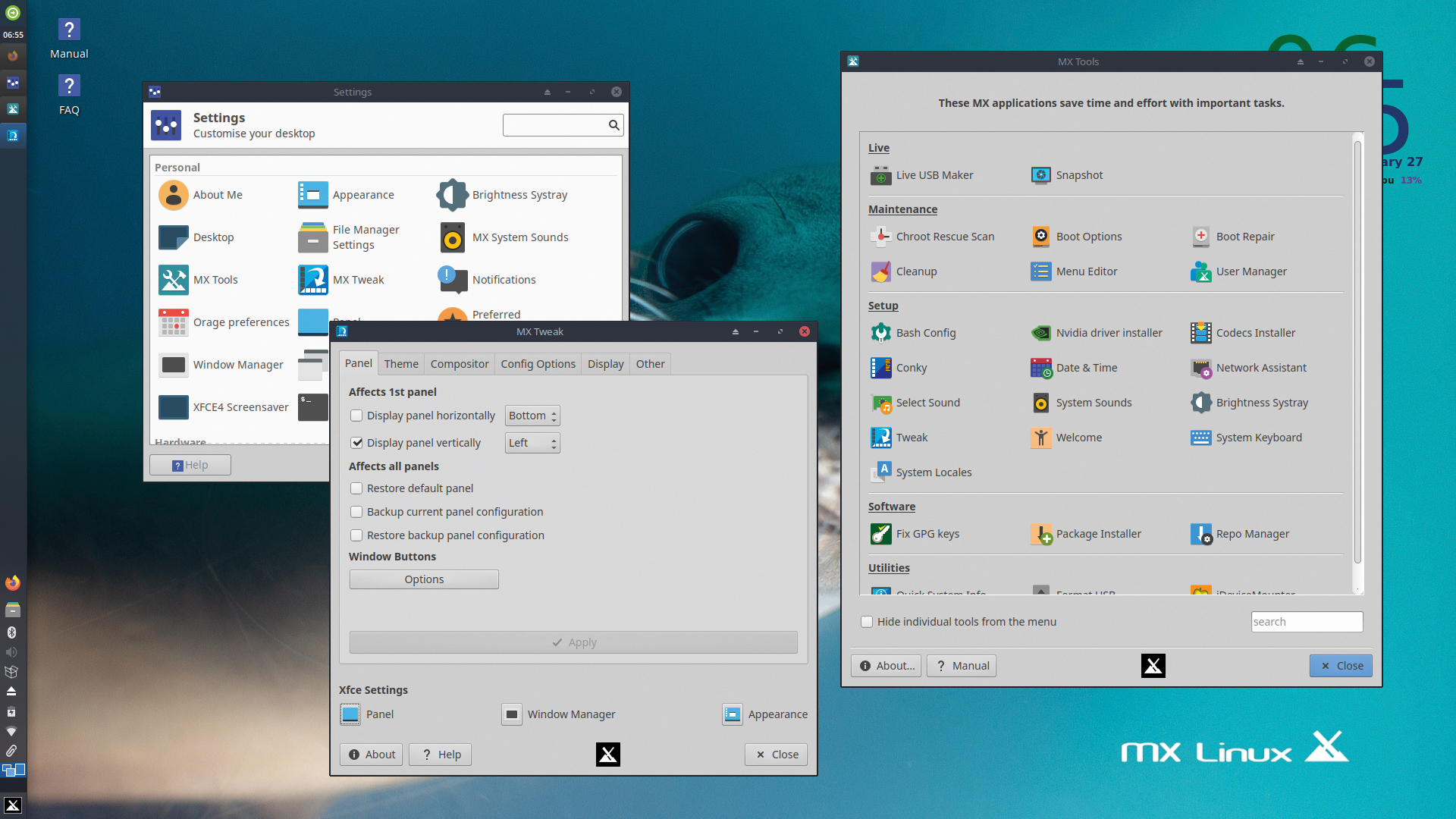Switch to Linux with these top distros
Windows 7 is dead; it might be time consider switching to a stable, secure and fast alternative

More than most of the other distros on test, MX Linux feels like something that was put together by a loose collection of enthusiasts. It doesn’t have quite the same level of polish as something like Ubuntu or Mint, although this may be a consequence of the fact that it’s designed to be more lightweight than some of the other distros out there.
We had some trouble installing MX Linux, but it was well worth persevering. The main hurdle was that it froze halfway through booting the live USB; only by switching to the text view did we realise that it was waiting for us to log in at the command prompt. We did so, using the default root password, but then it couldn’t start the window server. An online search turned up plenty of advice (it wasn’t an unknown issue), with several forum posts suggesting that we update the kernel.
This is easy enough so long as you have a second PC to hand that can boot from your USB stick. From there, opening MX Tools lets you update the kernel on the live USB, write it back to the stick, then return the stick to your first PC and try booting again. That said, the fix didn’t work for us, so we sourced a recompiled ISO of the live OS, which booted first time using the most recent kernel.
More impressively, the live OS spotted our Wi-Fi, allowing us to get online before we even clicked install and, when we first booted the OS from our hard drive, the password we supplied in live mode was carried through, allowing us to download updates right away.
We were running version 19.1, released in December 2019. The version number before the point relates to the year at the end of which it was released, so expect MX Linux 20 to hit download servers around December this year.
Although our build used the Xfce window manager, it was set up for tap-to-click (unlike Manjaro), and two-fingered scrolling was active, although this – and even touch detection – occasionally broke after a sleep/wake cycle. More seriously, closing our laptop’s lid didn’t put it to sleep in our build’s default configuration – it simply switched off the display. We changed the power settings to hibernate the machine when the lid was closed but this didn’t rectify the issue on our hardware.

System-wide settings are well organised and split across two apps called Settings Manager and MX Tools. The latter will more often bring you into contact with tweaks that require root access, so splitting them off from run-of-the-mill options is sensible, as it’s likely to cause less confusion among new users.
Windows switchers shouldn’t get lost, even though the taskbar is vertical. You’ll get used to it soon enough, but there is an option to set it to horizontal (pick Desktop from the Panel Preferences). If you want to make more extensive changes, dip into the MX Tweak tool where you can play with themes, display zoom and behaviours.
The application menu is categorised and searchable, and there’s a package manager for installing anything that doesn’t come as standard. The default bundle includes LibreOffice, Firefox and Thunderbird; Clementine and VLC for music and video; and a range of accessories and tools. Our wireless printer and network scanner were both detected, and we had no problems connecting to and browsing our NAS.
There’s a separate updater app lodged in the taskbar, the icon for which switches between an empty wireframe box when you’re fully patched and a solid green box when updates are waiting – it’s a simple and effective touch.
It’s sprightly, too, achieving a single-core score of 1,065 in Geekbench 5, and 2,071 when running the multicore test. We ran the tests a second time to be sure that wasn’t a fluke, and while the single-core result dropped slightly, to 1,054, multicore nudged up two notches to 2,073, making it an excellent choice for any user for whom performance is a must.
MX Linux is attractive and flexible, and there’s every chance you’ll find it works perfectly on your hardware. We found that some of the other options on test were better suited to our particular setup but, as with most Linux builds, you’ll have to make allowances for the fact the operating system and whichever machine you’re installing it on weren’t necessarily designed to work specifically together.
Get the ITPro daily newsletter
Sign up today and you will receive a free copy of our Future Focus 2025 report - the leading guidance on AI, cybersecurity and other IT challenges as per 700+ senior executives
Nik Rawlinson is a journalist with over 20 years of experience writing for and editing some of the UK’s biggest technology magazines. He spent seven years as editor of MacUser magazine and has written for titles as diverse as Good Housekeeping, Men's Fitness, and PC Pro.
Over the years Nik has written numerous reviews and guides for ITPro, particularly on Linux distros, Windows, and other operating systems. His expertise also includes best practices for cloud apps, communications systems, and migrating between software and services.
-
 Bigger salaries, more burnout: Is the CISO role in crisis?
Bigger salaries, more burnout: Is the CISO role in crisis?In-depth CISOs are more stressed than ever before – but why is this and what can be done?
By Kate O'Flaherty Published
-
 Cheap cyber crime kits can be bought on the dark web for less than $25
Cheap cyber crime kits can be bought on the dark web for less than $25News Research from NordVPN shows phishing kits are now widely available on the dark web and via messaging apps like Telegram, and are often selling for less than $25.
By Emma Woollacott Published
-
 Tiny11 review: Windows 11 with only 2GB of RAM
Tiny11 review: Windows 11 with only 2GB of RAMReview A version of Windows 11 for older machines that don't meet the full requirements
By Nik Rawlinson Published
-
 Red Hat Enterprise Linux becomes foundational operating system for Cohesity Data Cloud
Red Hat Enterprise Linux becomes foundational operating system for Cohesity Data CloudNews New strategic partnership between Red Hat and Cohesity aims to drive innovation in the data security and management space
By Daniel Todd Published
-
 Ubuntu shifts to four-week update cycle
Ubuntu shifts to four-week update cycleNews Critical fixes will also come every two weeks, mitigating the issues involved with releasing prompt patches on the old three-week cadence
By Richard Speed Published
-
 AlmaLinux follows Oracle in ditching RHEL compatibility
AlmaLinux follows Oracle in ditching RHEL compatibilityNews Application binary compatibility is now the aim with 1:1 now dropped
By Richard Speed Published
-
 How big is the Windows 10 cliff-edge?
How big is the Windows 10 cliff-edge?ITPro Network With some comparing the upcoming Windows 10 end of life to Windows XP, we ask members of the ITPro Network for their insight
By Jane McCallion Published
-
 Everything you need to know about the latest Windows 11 updates - from bug fixes to brand-new features
Everything you need to know about the latest Windows 11 updates - from bug fixes to brand-new featuresNews Two new cumulative updates are on the way and will be installed automatically on Windows 10 and Windows 11 machines
By Rory Bathgate Published
-
 How to download a Windows 11 ISO file and perform a clean install
How to download a Windows 11 ISO file and perform a clean installTutorial Use a Windows 11 ISO to install the operating system afresh
By John Loeppky Published
-
 We could all benefit from better Windows and macOS accessibility features
We could all benefit from better Windows and macOS accessibility featuresOpinion Today’s accessibility features can help you work through a nasty injury, but there’s still plenty of room for improvement
By Barry Collins Published